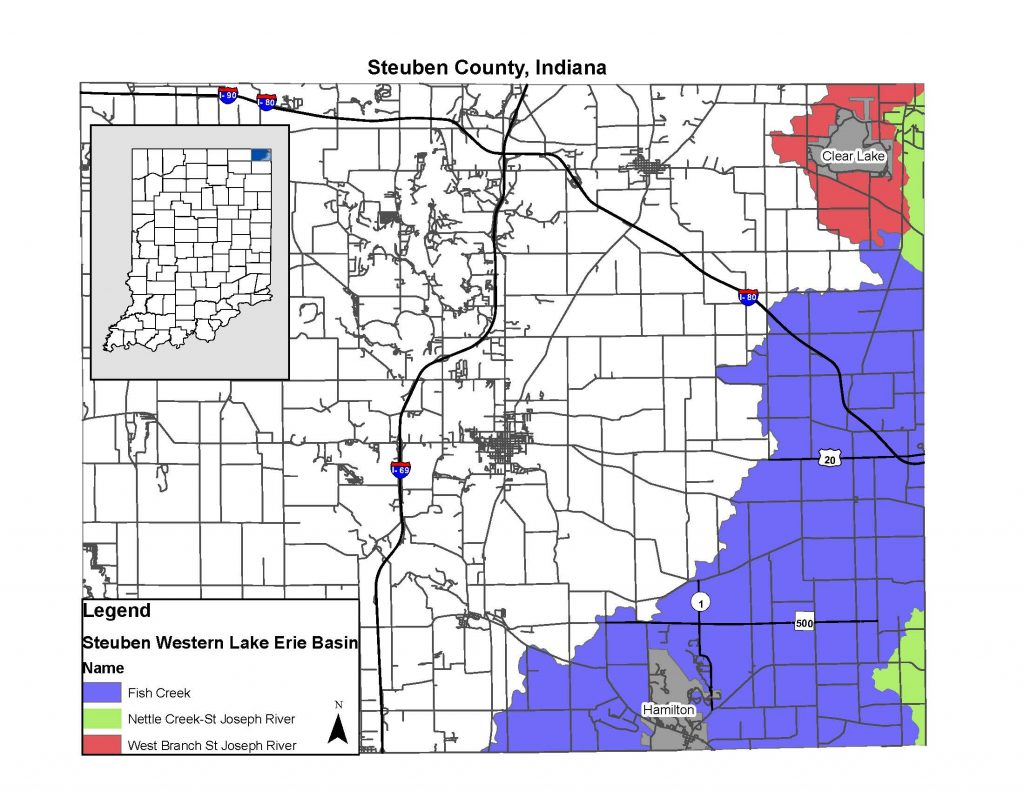The Western Lake Erie Basin (WLEB) watershed is one of our nation’s most significant collections of inland rivers and streams. The WLEB covers nearly 7 million acres and it encompasses most of northwest Ohio, as well as portions of northeast Indiana and southeast Michigan. Specific to our area, it covers about a third of Steuben County and most of Dekalb County. Around 75 percent of the land is in agricultural production and approximately 1.2 million people live in the basin. Lake Erie is one of the most productive fisheries of the Great Lakes, and it provides drinking water to around 14 million people.
Since the mid-1990’s, dissolved phosphorous loading to the WLEB has increased. During the same time period, adoption of conservation practices has led to a reduction in sediment and total phosphorus reaching the lake. However, the increasing levels of dissolved phosphorus flowing into Lake Erie contribute to the size of Harmful Algal Blooms (HABs) in the lake in the summer and fall months each year. There is a crucial need for reduction in dissolved phosphorus, and continued reductions of sediment, total phosphorus, and nitrogen to decrease HABs in the lake.
Indiana is working with landowners in our communities to help improve the water quality of our streams and inland rivers, and ultimately Lake Erie. The simplest ways to do this are to decrease the sources, reduce erosion, and manage water leaving the land. The Steuben County Soil and Water Conservation District (SWCD) recently received a grant from the Lake and River Enhancement Program (LARE) to promote and lend technical assistance to landowners desiring to implement agricultural Best Management Practices (BMPs) within the West Branch, Nettle Creek, and Fish Creek subwatersheds of the WLEB. Watch for updates on this award in the coming weeks.
Source: ISDA webpage, October 7, 2021

Southeastern Steuben County is a part of the Western Lake Erie Basin watershed.
To restore and protect the waters of the Great Lakes, the United States and Canada have a commitment through the Great Lakes Water Quality Agreement (GLWQA). The U.S. and Canada first signed the Agreement in 1972; it was further amended in 1983, 1987, and 2012. In 2012, the Agreement was updated to enhance water quality programs to ensure the “chemical, physical, and biological integrity” of the Great Lakes. The GLWQA comprehensively addresses priority challenges to the water quality and ecosystem health of the Great Lakes organized by 10 issue annexes, including: Areas of Concern; Lakewide Management; Chemicals of Mutual Concern; Nutrients; Discharges from Vessels; Aquatic Invasive Species; Habitat and Species; Groundwater; Climate Change Impacts, and Science.
Through the Nutrients Annex of the 2012 Great Lakes Water Quality Agreement, Canada and the U.S. committed to coordinate binational actions to manage phosphorus concentrations and loadings, and other nutrients if warranted, in the Waters of the Great Lakes. Indiana has been an active member of the Nutrients Annex since its establishment. Indiana’s commitment under the Nutrients Annex included the development of a Domestic Action Plan (DAP) to assist in meeting near shore and open water phosphorus objectives and loading targets established for Lake Erie. Both the U.S. and Canada have agreed to reduce phosphorus entering the lake by 40%.
Indiana’s Great Lakes Water Quality Agreement (GLWQA) Domestic Action Plan (DAP) for the Western Lake Erie Basin (WLEB) to reduce phosphorus to the WLEB is the product of a dedicated Advisory Committee comprised of representatives from different stakeholder sectors and is led by the Indiana Department of Environmental Management (IDEM). The Steuben County SWCD is an advisory committee member and was involved in the development of the DAP and milestone table.
Western Lake Erie Basin Sediment and Nutrient Load Reductions 2019
Indiana Department of Environmental Management – Maumee River Watershed Management Plan
Indiana Department of Natural Resources – Lake and River Enhancement Program (LARE)
Indiana Soil and Water Conservation District Initiatives
Indiana USDA Natural Resources Conservation Service – Western Lake Erie Basin Initiative
Indiana USDA Natural Resources Conservation Service – Great Lakes Restoration Initiative